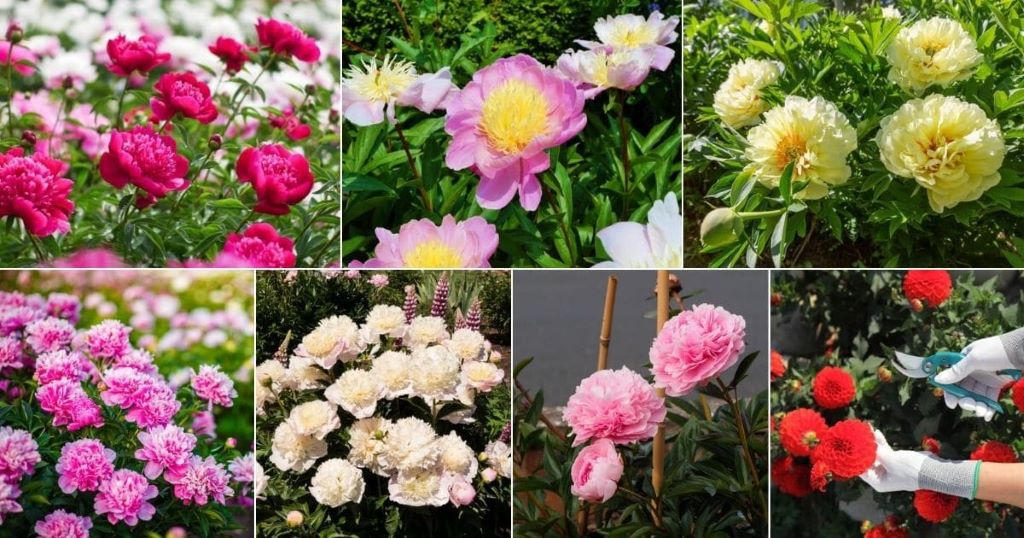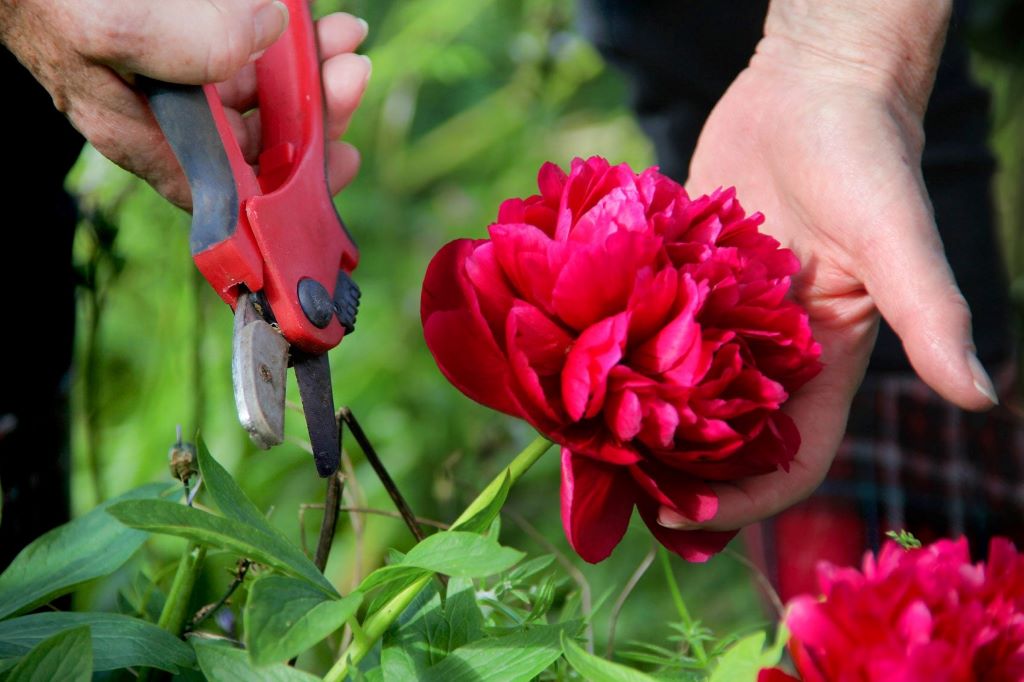As the weather warms and spring arrives, peony bushes start to send up their lush, full blooms. These perennial flowers are prized for their gorgeous blossoms and lovely fragrance. With proper care and attention, your peonies will continue to thrive and delight you with their beauty year after year. Follow this guide on caring for peonies in spring to learn the ins and outs of peonies in spring.
Getting Peonies Ready for Spring

Before your peonies begin to sprout and grow in spring, you should do a few things to prep the plants and set them up for success.
Cut Back Last Year’s Growth
Trick back the peonies stems from the previous year in early spring before new growth emerges. Cut the stems down to about 1-2 inches above the ground. This removes old, dead growth and helps direct the plant’s energy into the new stems that will emerge.
Divide Overgrown Plants
Mature peony plants that are overcrowded or failing to bloom well can benefit from division in early spring. Carefully dig the plant and roots and gently pry the central clump into sections—Replant divisions in holes 2-3 times as wide as the root ball and water well.
Fertilize Established Plants
Applying fertilizer in early spring gives peonies a nutritional boost right when they need it most as growth begins. Use a balanced 10-10-10 fertilizer or one explicitly formulated for perennials. Follow package directions on how much to apply.
Remove Mulch
If you mulch your peonies over winter, remove any remaining mulch as new growth emerges in spring. Mulch covering emerging stems and leaves can cause rot and other problems.
Caring for Peony Foliage and Stems

Once peonies begin actively growing in spring, proper care of the stems, leaves, and overall plant growth is essential. Here are tips for tending to peony foliage and stems all season long.
Stake Tall Varieties
Some peony varieties grow quite tall, up to 3-4 feet. Stake these tall stems as they emerge to provide needed support once blooms appear. Use peony rings or plant supports to keep plants upright and prevent flopping.
Disbud for Larger Blooms
Many gardeners choose to disbud peonies or remove the smaller side buds along the stems to direct all the plant’s energy into the primary flower buds. This results in fewer but much more prominent blooms—Disbud when buds are the size of peas.
Deadhead Spent Blooms
Once peonies finish flowering, promptly deadhead or remove the spent blooms. This keeps plants looking tidy and prevents seed formation, which saps energy from the plant. Snip off blooms just below the flower head.
Monitor for Pests and Diseases
Keep an eye out for signs of pest or disease problems on peony leaves and stems, treating any issues promptly. Common peony afflictions include botrytis blight, leaf spots, powdery mildew, and Japanese beetles. Remove affected foliage and treat it appropriately.
Water Weekly During Growth
Peonies need about 1-2 inches of water per week from rain or supplemental watering during their active growth and flowering period. Soak the soil deeply, not splashing water on leaves or blooms, to avoid disease.
Stop Staking After Bloom
Once peonies have finished flowering, you can remove any stakes, rings, or supports you’ve been using. Allow the stems to naturally fall over as seeds form to prevent damage to the plant.
Caring for Peony Roots
The roots of peonies require special care and attention since the plants spend winters dormant underground. Follow these tips for properly maintaining peony roots all season long.
Don’t Bury Roots Too Deep
When first planting peonies, don’t bury the roots too deeply. The eyes or growth buds should be 1-2 inches below the soil surface. Suppressing too intensely can lead to poor growth.
Avoid Disturbing Roots
Peonies dislike having their root systems disturbed. Once planted, avoid digging around or moving peony roots unless necessary. Disrupting roots can set plants back for years.
Mulch Over Winter
When plants go dormant in fall, apply a 2-4 inch layer of shredded bark, leaves, straw, or other organic mulch over the root zone. This insulates roots from cold damage during winter. Remove mulch in spring as growth resumes.
Propagate by Division
The best way to propagate peonies is by division in early fall. Carefully dig up mature plants, gently pry root clumps apart, and replant divisions to multiply your peony collection.
Don’t Plant Too Deeply
When planting peonies, ensure the eyes or growth buds are produced no more than 1-2 inches below the soil. Growing too deeply is a common mistake that results in poor growth.
Check for Root Problems
If peonies abruptly decline, carefully dig up roots and check for issues like rot, borers, or nematodes. Discard badly infected roots and replant in new soil to restart. You can also treat nematodes by solarizing soil.
By properly tending to peony roots, foliage, stems, and flowers as described here, you can enjoy robust, floriferous peony plants that will thrive for years. Please pay close attention to their needs in springtime as growth resumes. With a bit of care and effort, you’ll be rewarded with gorgeous blooms.
Troubleshooting Common Peony Problems

Even well-cared-for peonies can sometimes have issues arising. Here are some common peony problems and how to remedy them:
Yellowing Leaves
If peony leaves turn yellow, it’s often due to overwatering or poor drainage. Allow soil to dry out between waterings and amend with compost to improve drainage. Remove any afflicted foliage.
Wilting Flowers
Peonies with wilting flowers during warm weather may indicate botrytis blight, a fungal disease. Improve air circulation around plants and remove infected tissue. Avoid wetting foliage and water at the soil level.
Holes in Leaves
Holes chewed in peony leaves are likely the work of Japanese beetles. Hand-pick beetles from plants and use insecticidal soap sprayed only on foliage as needed. Cover buds with mesh bags to protect them.
Failure to Bloom
If a mature peony fails to bloom, it often indicates the plant was planted too deeply. Carefully dig up and replant, ensuring only 1-2 inches of soil cover the roots and growth buds.
Ants on Buds
Ants climbing on peony flower buds are not harming the plant. They are likely feeding on the sugary substance secreted by the buds. Hose off ants with water if desired.
By diagnosing issues promptly and taking appropriate actions, you can get your peonies back to health and look their best. Pay close attention to any signs of problems.
Frequently Asked Questions
1. When should I prune back peony stems in spring?
Prune peony stems before new growth begins in early spring, cutting checks to 1-2 inches above soil level. This removes old dead growth and redirects energy into the emerging stems.
2. Do peonies need to be fertilized in spring?
Applying a balanced fertilizer in early spring as growth resumes is recommended. This gives peonies a nutritional boost when they need it most. Use an all-purpose or perennial fertilizer.
3. How much water do peonies need in spring?
Peonies demand consistent moisture during spring’s active growth and bloom time. Aim to provide 1-2 inches of water per week from rain or supplemental watering. Deep weekly soakings are better than frequent light sprinklings.
4. When should I remove stakes from peonies in spring?
Remove any peony stakes, rings, or supports once the blooms have finished and plants begin to form seeds. Allowing stems to fall over prevents damage.
5. How deeply should I plant peonies?
Proper peony planting depth is critical – eyes or growth buds should be only 1-2 inches below the soil surface. Planting too deeply results in poor growth and lack of blooms.
Proper spring care ensures peonies get off to a great start. Focus on pruning, fertilizing, watering, and monitoring for problems. With the appropriate care, your peonies will flourish.
Conclusion
Caring for peonies in spring is about providing what they need to leap into vigorous growth and flowering. As growth resumes, monitor peony foliage and stems. Stake tall varieties for support, disbud for larger blooms, promptly deadhead spent flowers, and watch for pest or disease issues. Deep weekly watering is essential during this active period.
Transform your balcony into a lush, green oasis with our beginner’s guide to balcony gardening, where we highlight the importance of proper peony root care in spring, ensuring that these roots are planted at the right depth and undisturbed for optimal growth. Mulch overwintered roots in fall and remove mulch as growth starts in spring. Check for any signs of root damage or disease and address issues promptly.
Tags: blooming tips, floral care, flower maintenance, garden beauty, garden enhancement, peony care, peony growth, plant health, seasonal plants, spring gardening



